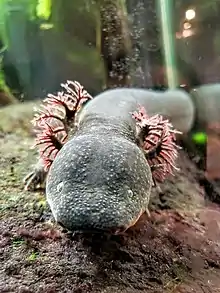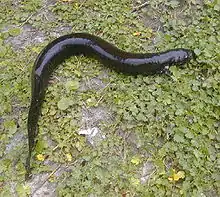Greater siren
The greater siren (Siren lacertina) is an eel-like amphibian and one of the three members of the genus Siren. The largest of the sirens and one of the largest amphibians in North America, the greater siren resides in the coastal plains of the southeastern United States.
| Greater siren | |
|---|---|
 | |
 | |
| Scientific classification | |
| Kingdom: | Animalia |
| Phylum: | Chordata |
| Class: | Amphibia |
| Order: | Urodela |
| Family: | Sirenidae |
| Genus: | Siren |
| Species: | S. lacertina |
| Binomial name | |
| Siren lacertina Linnaeus, 1766 | |
Description
S. lacertina is paedomorphic, as are all sirens. They lack hindlimbs as well as a pelvic girdle, and have external gills all throughout their lives along with small lungs. They lack eyelids, and have an unfused pectoral girdle.[3] Greater sirens measure around 1.5 cm (0.59 in) in length upon hatching and then grow to lengths ranging from 18 to 97 cm (7 to 38 in).[4][5][6] Weight can range from 55 to 1,000 g (1.9 to 35.3 oz).[7][8] Coloration varies throughout their range, but they are generally an olive or gray color with small yellow or green dots on their sides. They have about 36 to 40 costal grooves between their armpits and their cloaca.[9] Younger sirens also have a light stripe along their sides, which fades with age. The front legs, each with four toes, are so small that they can be hidden in the gills.
In terms of sensory organs, greater sirens rely on both a modified Jacobson's organ and a lateral line system over their small eyes. It is possible that they are capable of sensing disturbances in electrical fields.[10]
.jpg.webp) Greater siren skull & hyoid
Greater siren skull & hyoid.jpg.webp) Greater siren skeleton
Greater siren skeleton
Behavior

Greater sirens are carnivorous and prey upon invertebrates and aquatic vertebrates with a possible preference for molluscs,[9] although they have been observed to eat vegetation.[11] They are nocturnal and spend the day in dense vegetation.[10] Their lifespan in the wild is unknown, but in captivity they can live up to 25 years. Greater sirens can vocalize, producing clicks or yelps sounding similar to the call of the American green tree frog.[9] They are able to aestivate for multiple years if necessary, burrowing into mud and exuding a cocoon of dead skin cells. Known predators include the American alligator and the mud snake.[10]
Their spermatozoa possess a pair of flagella, and their courtship behavior is unknown.[3] Mating occurs in February and March, with mothers guarding clutches of eggs that hatch about two months later. Youth live in shallower water than adults, often among the roots of water hyacinths.[10]
Distribution
They inhabit the coastal plain from Washington, D.C., to Florida and Alabama.[12] A population of sirens in the Rio Grande has been tentatively determined to be S. lacertina. Greater sirens live in wetlands, preferring those with a slow or nonexistent current and a thick layer of organic material. They are capable of inhabiting seasonal and permanent wetlands given their ability to aestivate,[9] and will burrow into mud if their wetland dries up.[12]
Conservation
Greater sirens are classified as Least concern by the International Union for Conservation of Nature, although they have been extirpated from some of their former range due to habitat loss. They are protected under Mexican law and are assigned to the "Special Protection" category.[12]
References
- Fossilworks
- Parra-Olea, Gabriela; Wake, David and Hammerson, Geoffrey (2004). Siren lacertina. In: IUCN 2012. IUCN Red List of Threatened Species. Version 2012.2.
- Vitt, Laurie J.; Caldwell, Janalee P. (2014). Herpetology (Fourth ed.). 32 Jamestown Road, London NW1 7BY, UK: Elsevier. ISBN 978-0-12-386919-7.CS1 maint: location (link)
- Heisler, N.; Forcht, G.; Ultsch, G.R.; Anderson, J.F. (1982). "Acid-base regulation in response to environmental hypercapnia in two aquatic salamanders, Siren lacertina and Amphiuma means". Respiration Physiology. 49 (2): 141–58. doi:10.1016/0034-5687(82)90070-6. PMID 6815749.
- Greater Siren – North Carolina. Herpsofnc.org (2007-09-22). Retrieved on 2013-01-03.
- Siren intermedia. AmphibiaWeb (2003-12-04). Retrieved on 2013-01-03.
- Martin, Karen M.; Hutchison, Victor H. (1979). "Ventilatory Activity in Amphiuma tridactylum and Siren lacertina (Amphibia, Caudata)". Journal of Herpetology. 13 (4): 427–434. doi:10.2307/1563477. JSTOR 156347.
- Deyle, Anna C. (2011) Population Genetics of Amphiuma means and Siren lacertina in Central Florida. M.S. Thesis, University of South Florida
- . "Greater Siren (Siren lacertina) Savannah Rive Ecology Laboratory. University of Georgia.
- McKenzie, Kimberley. "Siren lacertina". Animal Diversity Web. University of Michigan Museum of Zoology. Retrieved 25 March 2018.
- Hill, Robert L.; Mendelson III, Joseph R.; Stabile, Jennifer L. (2015). "Direct Observation and Review of Herbivory in Sirenidae (Amphibia: Caudata)". Notes of the Southeastern Naturalist. 14 (1): N5–N9.
- IUCN. "Siren lacertina". IUCN Red List of Threatened Species. Retrieved 25 March 2018.
